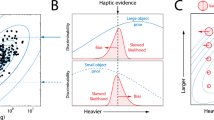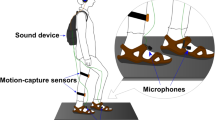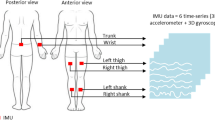Abstract
IT has been suggested1,2, and repeated in textbooks3, that the size–weight illusion is due to differences in muscle tension while weights are being lifted. A large object is lifted with more initial force than a small object, and is judged lighter than a smaller object of the same weight because it can be raised more easily. Several authors4–8 have investigated the differences in muscular effort which accompany errors of weight judgment, but the reports are inconsistent. (Some of these studies1,5,6 were concerned with the “time error” rather than the size-weight illusion.) If certain tension changes were firmly established this would not be sufficient evidence that they were the cause of the illusion: both might be caused by some other factor. The illusion can be a result of pressure without lifting9,10. Uznadze10 demonstrated this by placing pyramids of equal base areas, but different heights, on an arm at rest. I also found that the illusion was experienced to its normal extent when the weights were hung by wire loops from a supported hand11.
This is a preview of subscription content, access via your institution
Access options
Subscribe to this journal
Receive 51 print issues and online access
$199.00 per year
only $3.90 per issue
Buy this article
- Purchase on SpringerLink
- Instant access to full article PDF
Prices may be subject to local taxes which are calculated during checkout
Similar content being viewed by others
References
Müller, G. E., and Schumann, F., Arch. Ges. Physiol., 45, 37 (1889).
Claparède, E., Arch. de Psychol., 1, 69 (1902).
Woodworth, R. S., and Schlosberg, H., Experimental Psychology, 227 (Methuen, London, 1955).
Loomis, H. N., Psychol. Monog., 8, 334 (1907).
Payne, B., and Davis, R. C., J. Exp. Psychol., 27, 227 (1940).
Freeman, G. L., and Sharp, L. H., J. Exp. Psychol., 29, 23 (1941).
Bzhalava, I. T., Voprosy Psikhologii, 4, 42 (1958), trans. in Recent Soviet Psychology, edit. by O'Connor, N. (Pergamon, Oxford, 1961).
Werber, M., and King, D. J., J. Gen. Psychol., 66, 85 (1962).
Bochorishvili, A. A., Bull. Tbilisi Univ., 3 (1927, cited by Bzhalava, 1958).
Uznadze, D., Psychol. Forsch., 14, 366 (1931).
Ross, H. E., The Effect of Apparent versus Physical Stimulus Magnitude upon Sensory Discrimination (unpublished thesis, Cambridge Univ., 1965).
Howard, I. P., Durham Res. Rev., 1, 47 (1954).
Fischel, H., Zeit. Psychol., 98, 342 (1926).
Author information
Authors and Affiliations
Rights and permissions
About this article
Cite this article
ROSS, H. Sensory Information necessary for the Size–Weight Illusion. Nature 212, 650 (1966). https://doi.org/10.1038/212650a0
Published:
Issue date:
DOI: https://doi.org/10.1038/212650a0
This article is cited by
-
The size-weight illusion is unimpaired in individuals with a history of congenital visual deprivation
Scientific Reports (2021)
-
Individualistic weight perception from motion on a slope
Scientific Reports (2016)
-
Felt heaviness is used to perceive the affordance for throwing but rotational inertia does not affect either
Experimental Brain Research (2013)
-
Diminished size–weight illusion in anorexia nervosa: evidence for visuo-proprioceptive integration deficit
Experimental Brain Research (2012)



